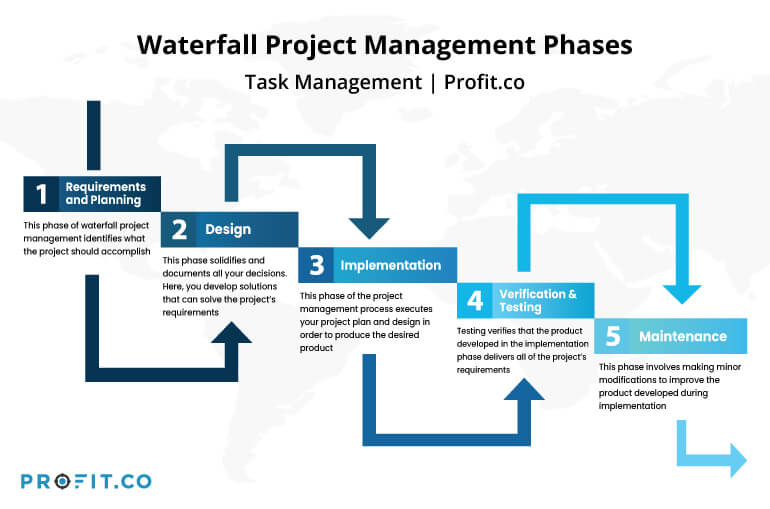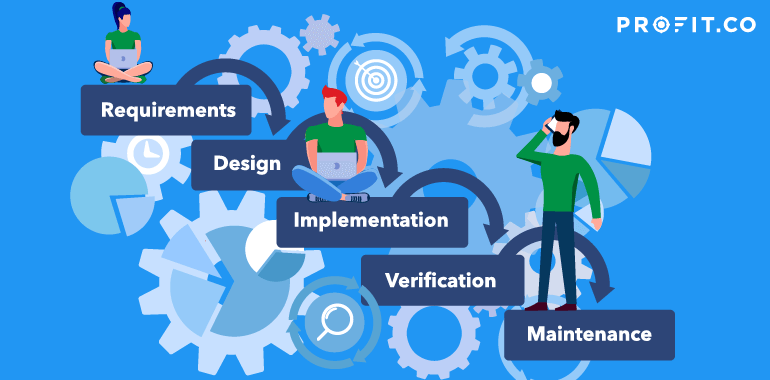The Five Phases of Waterfall Project Management: Its Advantages and Disadvantages
Have you ever wondered why Elon Musk, Jeff Bezos, Bill Gates, and the rest of Silicon Valley have successful projects? The answer is outstanding project management, which ensures successful implementation from start to finish.
Good business leaders create a vision, articulate the vision, passionately own the vision, and relentlessly drive it to completion.
What is Waterfall Project Management?
The waterfall approach is among the oldest project management techniques. It consists of sequential phases that map out every essential step of a project.

Each new step feeds into the next step in such a way that one can’t begin without the previous phase’s completion. When changes occur, they are costly because a phase’s completion does not allow you to revisit it unless you restart the project from phase one.
Waterfall Project Management Phases
Phases of waterfall project management differ from one project to another. But generally, you can group the activities of the waterfall approach into five stages: planning, design, implementation, verification, and maintenance.
1. Requirements and Planning
The requirements and planning phase of waterfall project management identifies what the project should do. The project manager tries to understand the project’s requirements based on what the project sponsors need. This phase involves identifying and describing the project’s risks, assumptions, dependencies, quality metrics, costs, and timeline.
2. Design
The design phase solidifies and documents all your decisions. In this case, you develop solutions that can solve the project’s requirements. The best way to do so is to note all the actions you’ll take to deliver the project scope to execute them.
Design covers the project’s schedule, budget, and objectives, and you can think of design as a blueprint or road map to the complete project.
3. Implementation
The implementation phase executes your project plan and design to produce the desired product. If your company develops software, you will spend this phase coding the software functionalities. Or, if you’re managing a project at a construction company, you will construct a house in this phase.
Implementation takes up a significant portion of waterfall project management. Everything that happens during this phase should be carefully documented.
4. Verification/Testing
Testing verifies that the product developed in the implementation phase fulfills the entire project’s requirements. If this is not the case, the project team must review the project from phase one to identify what went wrong. The testing phase uses various quality metrics and customer satisfaction to measure the project’s success.
5. Maintenance
The maintenance phase extends beyond the five stages of project management into the project’s lifetime. This phase involves making minor modifications to improve the product developed during implementation and performing other routine maintenance tasks. It’s also a phase to identify any errors you might have missed during the testing phase.
Waterfall Project Management Tools
Waterfall project management tools contribute to the successful implementation of the project. They include:
- Communication tools like Slack
- Collaboration tools like Microsoft Teams
- Note-taking tools like whiteboards
- Work-specific tools
- Testing tools
- Planning tools like MS Projecs
If you would like a software that helps you transparently track company-wide goals and relate them directly to your team’s daily tasks, then you need Profit.co’s OKR Management software. You can get started on Profit.co free today!
Advantages and Disadvantages of Waterfall Project Management
Benefits and advantages of waterfall project management:
- Simplicity in training
- Proof of progress
- Easy management
- It saves money and time
The waterfall approach focuses on thorough documentation, making it easier for new team members to follow the project’s progress. The new members can refer to the documentation to catch up on the project.
Waterfall project management clearly defines the project’s milestones in the requirements and planning phase. It is easier to identify the project’s progress by reviewing these milestones. The distinct steps of the technique also clearly indicate how close the project is to completion.
Waterfall-based projects are easy to manage because of their linear nature, and it is easier to identify the project’s progress at any given time. If changes occur, you can easily refer to the waterfall documentation to see how you can address them.
The waterfall approach emphasizes conceptualization and detailed documentation. The two activities better prepare for executing a project correctly in its first trial. Understanding the project’s needs and implementation plan from early on can save you the time, money, and effort that would arise from revisions.
Disadvantages of the waterfall project management approach:
- Inflexible and resistant to change
- Focuses on one phase at a time
The waterfall approach consists of sequential steps that pour into each other. So, the outcomes of one phase of the project are absolutely necessary in order to move onto the next phase. Changes in one phase imply that the whole waterfall process needs a review. This makes the management style difficult to change.
Phases of the waterfall approach are linear and sequential. No two processes can run simultaneously. This can be disadvantageous if personnel required for an early phase is backlogged, and the project grinds to a halt because of it.
Waterfall vs. Rapid Development
The waterfall project remains relevant despite new rapid management techniques like agile development. The waterfall approach focuses on the step-by-step implementation of a project. In contrast, agile project management focuses on iterative, shorter project cycles that deliver a working prototype to the client.
The project team continuously improves this prototype until the project is complete. Both techniques have benefits when utilized correctly. The waterfall approach will serve you well if you stick to traditional project management. But if you’re going to combine the old and the new, a hybrid waterfall methodology would be an excellent place to start your implementation.
In order to properly manage your projects and your company as a whole, you need to pair your chosen project management methodology with an agile OKR software. Profit.co’s OKR management tool combines OKRs, strategy, tasks, performance, and employee engagement on one central platform. To learn more about how Profit.co can help you better manage your team’s tasks, projects, and goals, book a free demo with our experts today!

